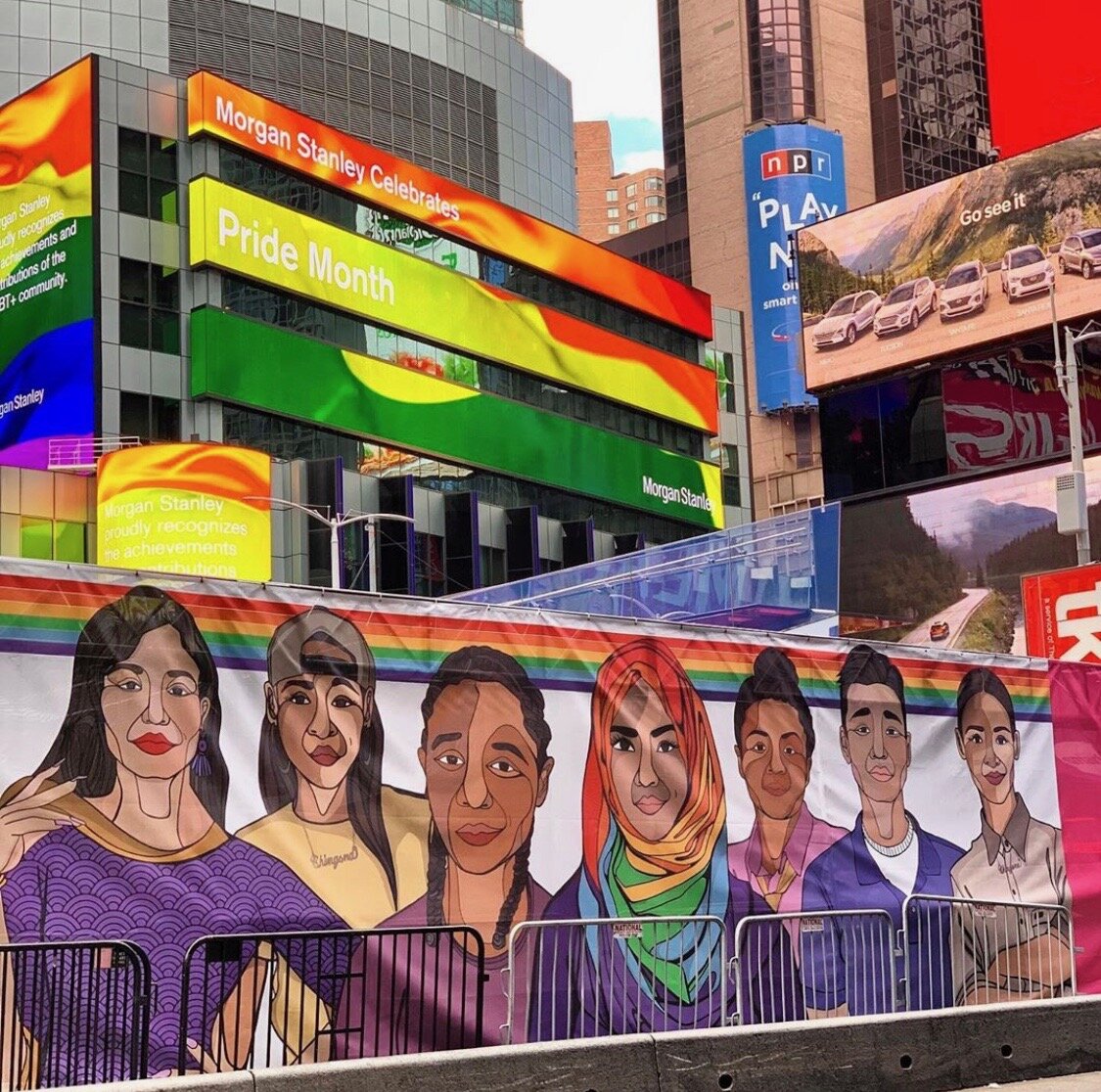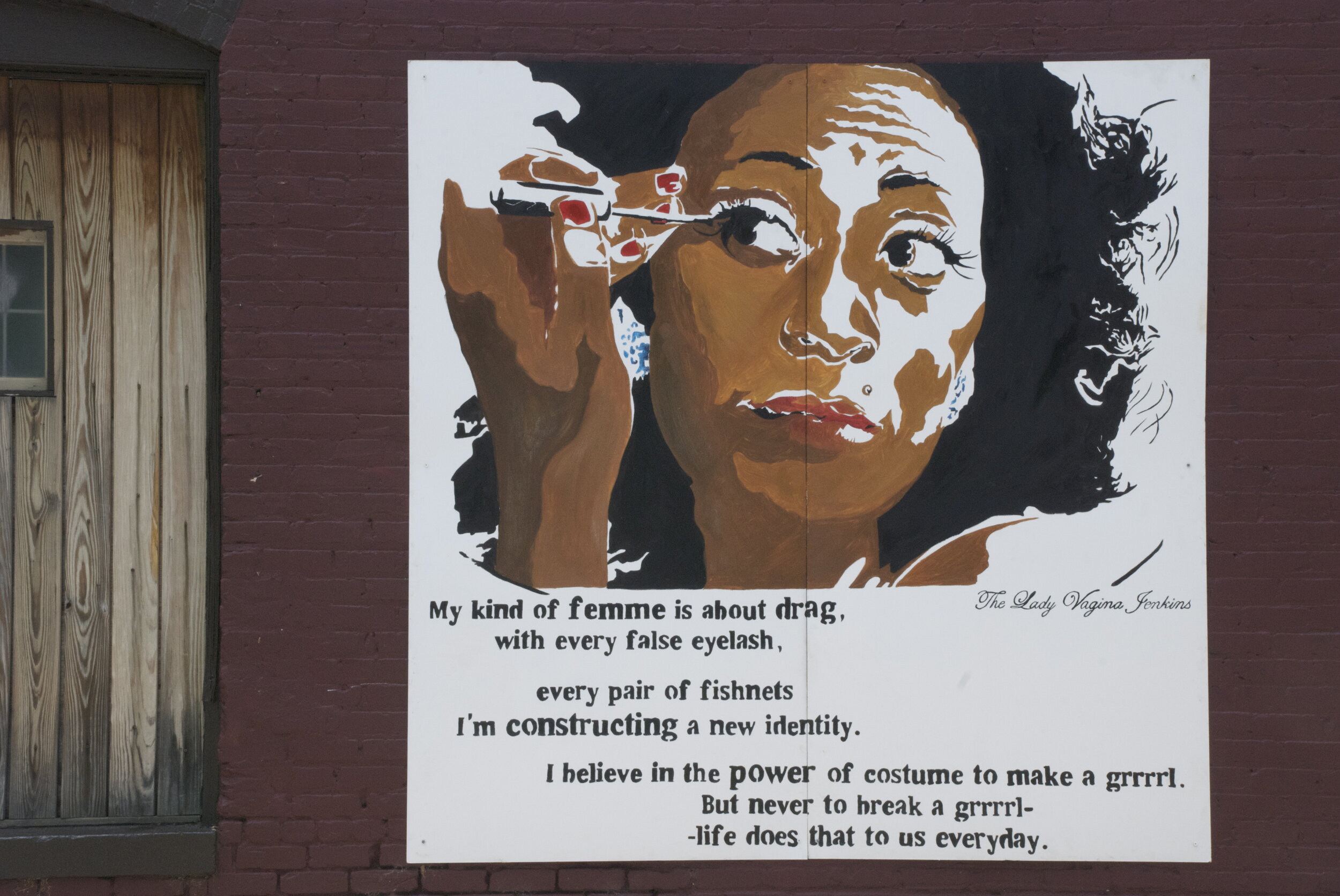Queering the Streets
(courtesy Sam Kirk) via Hyperallergic
The late and great Toni Morrison once said, “The best art is political.” And, furthermore, “you ought to be able to make it unquestionably political and irrevocably beautiful at the same time” – which, I might add, she did.
Art – especially that which exists for public consumption – does seem, to me (or maybe inherent in the sort I choose to consume), inextricably entwined with its broader cultural and political context. This context quickly becomes personal by virtue of the lens of the artist creating it. If art is a form of expression, then how then can we separate it from its creator and their experience? Especially when this experience is uncommon and “othered,” or the artist's identity marginalized, these broad, rich, and varied swaths of perspective tend to seep into the contours, imbuing their works with the vibrant shades of that particular creator's lived experience.
We at Body Type decided to pull together and highlight LGBTQIA+ artists that identify somewhere on or between the spectrums of sexuality and/or gender excerpted from this article I wrote for Hyperallergic on femme and non-binary street or public artists. We hope you enjoy this queering of the public art narrative and come away with the knowledge that there are always more pieces, artists, practices, etc. to dig into, learn about/from, or simply peruse.
On that note, feel free to send us some of your favorites, further reading, or artists you’d like us to highlight, even you! Email us at editor@wearebodypolitic.com should you have anything to add to the always ongoing conversation.
***
Fringe in its genesis in graffiti, street art can occupy municipal space and attention in a manner both subversive and democratic in its presentation and process. While it nods to a variety of forms, from Minimalism to Surrealism, it has not historically been taken seriously by the mainstream. This marginality enables street art to stay disruptive, full of potential to give marginalized narratives a public face.
Yet even in this countercultural niche, street art remains male-dominated. (Often, this is excused through alleged concerns around safety, due to its illicit nature in urban spaces at odd hours.) And much of what does constitute recognition for femme or nonbinary street artists rarely extends to people of color. To help combat this oversight, I sought out some talented femme, nonbinary, and/or queer artists who weave ideas around identity into their work.
This roster of profiles is neither exhaustive nor all-encompassing. For instance, there’s also Tatyana Fazlalizadeh, ‘a Black/Iranian visual artist’ who uses ‘visual art to address the daily oppressive experiences of marginalized people’ through painted portraits in galleries and the street. Shamsia Hassani, ‘one of Afghanistan’s first female street artists,’ creates vibrant murals that paint ‘women as strong independent figures.’ Alexandra Bell is ‘a multidisciplinary artist who investigates the complexities of narrative, information, consumption, and perception’ (her work long decorated the facade of Bed Stuy’s Playground Coffee Shop). Be sure to check them out.
Sam Kirk
Sam Kirk paints a swirl of magenta hair below a rendering of the Brooklyn Bridge. Often collaborating with her wife, she likes to incorporate people from all walks of life into her work. She’s quick to tell me how one of her favorites (a large-scale commission in Times Square for World Pride) incorporates a diverse swath of identities: women in rainbow hijabs, nonbinary and trans folks, rare public representations of love between women of color. Working with a variety of organizations, she hopes to impart how impactful seeing oneself in a civic space can be for women of color and the LGBTQ+ community — to lead by example in being ‘proud to be all those things.’
(courtesy Sam Kirk) via Hyperallergic
Kirk started out on a very different path, in marketing, but art commissions kept rolling in. Her work as a street artist picked up speed until it overtook her 9-5. But her roots are apparent in her art. As a queer woman often on the receiving end of hate crimes, growing up on Chicago’s South Side with a dearth of representation inspired her to paint that representation onto the walls of public spaces. But in 2019, obstacles still exist. Property owners in parts of Boystown in Chicago, and even in Harlem, didn’t approve of pieces she proposed. But Kirk perseveres. Following her mural for the Lisa Project commemorating Victoria Cruz on the 50th anniversary of Stonewall, Kirk intends to donate some 350 feet of banner (broken up into around 20 individual posters) plastered around Times Square for World Pride to LGBTQ+ centers around the country that may not have the funds to commission such work.
Jilly Ballistic
(photo by the author for Hyperallergic) via Hyperallergic
FREE PRESS KILLS FASCISM — Jilly B. is scrawled at the base of the subway stairs at Montrose Ave. FREE the KIDS. CAGE THE WHITE NATIONALISTS — JB floats against a black backdrop surrounded by subway tiles in the 36th St Queens-bound M/R in Astoria. At Christopher Street, Stonewall was a riot, be the brick drips in white spray paint — Jilly Ballistic’s signature style. More Dykes / Fewer Wallsbookend a trash can at the Morgan Ave Brooklyn-bound L. None of it is commissioned, or legal. (She tells me she was actually arrested once, but managed to keep her day job.)
Coming from a background as a writer, Jilly B, billed as ‘Patron Saint of the Underground,’ pastes up subway witticisms and apocalyptic WWII imagery that act as satirical critique. Although Ballistic adds that many of her works were conceived earnestly, ‘as a response to political news: Syrian violence, trump rolling back environmental laws, the Supreme Court deciding LGBTQ+ rights.’ Her sprawling letters often even critique her own line of work. Tags such as ‘commodity’ scribbled in gold paint beneath a crossed-out ‘graffiti’ indict the mainstream appropriation of the form, such as how galleries charge $25 a ticket to display once-free urban works.
Ballistic started out writing guerrilla ads for work on trash days as installations in and around Brooklyn, where she’s from. Since then, she’s collaborated with the likes of The Dusty Rebel on the forthcoming street art documentary Out On the Street, been in exhibitions like Of Women, By Women, and tagged the streets, walls, and subways (her favorite) of Portland, Austin, LA, and even Honolulu.
E. Oscar Maynard
(courtesy E. Oscar Maynard) via Hyperallergic
E. Oscar Maynard, who is genderqueer (women-identified with an asterisk, they specify), delves into questions of gender, citizenship, history, and what it means to occupy public space through their work. As their creative practice has evolved, it has involved less spray paint and more paper cutouts. But Maynard lauds how the street and a stencil work as a ‘portable, contrasty, heavy-hitting medium for a message being in the world in a very particular way.’ That ‘anybody passing by could interact with it’ makes street art not only accessible, but also necessary. Their poster Brook Bolen employs a series of questions about (in)visibility aimed at ascertaining how femmes queer femininity. As a masculine-of-center person, Maynard says, they sought to challenge assumptions masculine people make about femininity.
Their portfolio tackles subjects like shame, queerness, and class, elaborating on them to conceive more personal and nuanced narratives. From street art, their ‘first little art crush,’ Maynard added layers, expanding beyond flat graphics to print and composing hybrids, sold at a cost they and people they know can afford. Now Maynard’s paper cuts, drawn with an X-Acto knife, hearken back to stencils. The goal of the work — with their current medium of choice, the letterpress — ‘take these really hard things and wrap them in poetry” to disarm people when they read them. They want to make little totems “that folks can take and remember that they’re not alone in doing that work or feeling that thing, whatever it is.’
Lady Pink
(courtesy Lady Pink) via Hyperallergic
An Ecuadorian-American street artist who got her start in the 1970s and ‘80s, Lady Pink’s style often merges bodies with architectural elements. When asked about the distinction between art by men versus femme street artists, she responds quickly: ‘Style is style. If it kicks ass, it kicks ass.’
Initiated at freight trains and on the subways, almost always as the only girl in a crew, Pink claims she just ‘knew the right people’ in the right place at the right time. She admits that ‘being the token girl’ wasn’t always a disadvantage. She talked her way out of handcuffs, patrol cars, and precincts thanks to the cops’ paternalistic mentality. Since then, Pink has starred in the cult classic ‘80s film Wild Style and had her work shown in the Met, the Brooklyn Museum, the Whitney, and Holland’s Groninger Museum.
Still, her experience wasn’t without challenges. Pink, who is bisexual, dated a woman during that time and endured gay-bashing. Later, an anti-vandalism squad targeted her and her husband (street artist Roger Smith of SaneSmith) on several occasions — largely, she says because she is a woman of color — eventually forcing them from the city to a plant-and-animal-filled oasis they built upstate.
Despite the challenges, over the years, Pink has served as a role model, teaching art and aerosol in schools in and around New York. She says that encouraging and educating the next generation has become a cornerstone of her work. She’s proud of painting murals in districts that can’t pay for them. She asserts that for students with less access to art education, just ‘knowing a real live artist, and even with an unorthodox beginning (especially with that)’ can show them that “with passion and dedication, [they] too can be a success.’”
***
Happy almost* spring everyone!
*All the easier to get out there and explore these and many more artists and artworks for yourself!
***
Ilana Herzig is the Editorial Director of Body Type and a contributing editor and writer. Ilana is an arts & culture writer from California based in Brooklyn, interested in the crossroads of art, queerness, wellness, science, and social justice. Find Ilana on Instagram or check out her writing (+ occasionally photography) in places like Hyperallergic, The Los Angeles Times, No Man's Land, Hyperallergic, Psychology Today.









